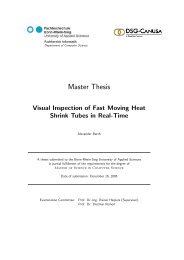Master Thesis - Hochschule Bonn-Rhein-Sieg
Master Thesis - Hochschule Bonn-Rhein-Sieg
Master Thesis - Hochschule Bonn-Rhein-Sieg
Create successful ePaper yourself
Turn your PDF publications into a flip-book with our unique Google optimized e-Paper software.
5. Algorithms <strong>Master</strong> <strong>Thesis</strong> Björn Ostermann page 82 of 126<br />
Since at this point the fluctuation noise and the robot have been identified, all other intrusions have to<br />
be dynamic objects.<br />
One main advantage of using the grown region rather than the position given by the robot’s PLC itself,<br />
is that the grown regions also automatically include tools and workpieces the robot is wielding.<br />
5.3 Detecting collisions<br />
In the dynamic workplace, collisions between the robot and other dynamic objects are possible. This<br />
can happen due to several facts:<br />
- The robot is approached by dynamic objects while standing still (stopped by the proximity<br />
monitoring).<br />
- The dynamic object is approaching the robot faster than the robot can avoid it, due to its reduced<br />
speed.<br />
- The robot has no more space for avoiding motions.<br />
If a collision between the robot and a dynamic object occurs their corresponding regions would merge,<br />
and the algorithm distinguishing the robot from other objects would include the object into the robot.<br />
This happens, since the robot is detected as the one region that includes the robot’s base centre (see<br />
chapter 5.2.4.3). The dynamic object would then be no longer considered an obstacle for the robot’s<br />
movement and the program would plan the robot’s movement accordingly, leading to possible<br />
injuries / damages to the intruding object.<br />
Figure 60a and b depicts the described case, where one of the dynamic objects from Figure 60a merges<br />
due to its movement with the robot in Figure 60b.<br />
To avoid this problem, the current robot region is checked against the intruding object regions,<br />
detected in the previous frame. If the robot region and the last frame’s object regions overlap, a<br />
collision took place (Figure 60c).














